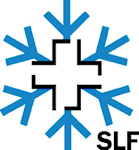SloMove
Validation of satellite- and ground-based monitoring systems for ground deformations
- Deutsch
- English
- Italiano
- Project duration: -
- Project status: finished
- Funding: Italy-Switzerland 2007-2013 (EUTC / EU funding / Project)
- Institutes: Institute for Earth Observation, Center for Climate Change and Transformation
In high mountain regions the choice of appropriate sites for infrastructure such as roads, railways, cable cars or hydropower dams is often very limited. In parallel, the increasing demand for supply infrastructure in the Alps induces a continuous transformation of the territory. The new role played by the precautionary monitoring in the risk governance becomes fundamental and may overcome the modeling of future events, which represented so far the predominant approach to these sort of issues. Furthermore the consequence of considering methodologies alternative to those more exclusive allow to reduce costs and increase the frequency of measurements, updating continuously the cognitive framework of existing hazard condition in most susceptible territories. The scale factor of the observed area and the multiple purpose of such regional ordinary surveys make it convenient to adopt Radar Satellite-based systems, but they need to be integrated with terrestrial systems for validation and eventual early warning purposes. Significant progress over the past decade in Remote Sensing (RS), Proximal Sensing and integration-based sensor networks systems now provide technologies, that allow to implement monitoring systems for ordinary surveys of extensive areas or regions, which are affected by active natural processes and slope instability. The Interreg project SloMove aims to provide solutions for such challenges and focuses on using remote sensing monitoring techniques for the monitoring of mass movements in two test sites, in South Tyrol (Italy) and in Grisons Canton (Switzerland).
The topics faced in this project concern mass movements and slope deformation monitoring techniques, focusing mainly on the integration of multi-temporal interferometry, new generation of terrestrial technologies for differential digital terrain model elaboration provided by laser scanner (TLS), and GNSS-based topographic surveys, which are used not only for validation purpose, but also for adding value and information to the whole monitoring survey. The test sites are currently observed by an original integrated methodology specifically developed within the aim of the project. The integrated monitoring design includes reference targets for the different monitoring systems placed together on the same point or rigid foundation, to facilitate the comparison of the data and, in the operational use, to be able to switch consistently from one to the other system. The principal goal of the project is to define a shared procedure to select scalable technologies, best practices and institutional action plans more adequate to deal with different sort of hazard related to ground displacement, in densely populated mountain areas containing recreational and critical infrastructures.
In high mountain regions the choice of appropriate sites for infrastructure such as roads, railways, cable cars or hydropower dams is often very limited. In parallel, the increasing demand for supply infrastructure in the Alps induces a continuous transformation of the territory. The new role played by the precautionary monitoring in the risk governance becomes fundamental and may overcome the modeling of future events, which represented so far the predominant approach to these sort of issues. Furthermore the consequence of considering methodologies alternative to those more exclusive allow to reduce costs and increasing the frequency of measurements, updating continuously the cognitive framework of existing hazard condition in most susceptible territories. The scale factor of the observed area and the multiple purpose of such regional ordinary surveys make it convenient to adopt Radar Satellite-based systems, but they need to be integrated with terrestrial systems for validation and eventual early warning purposes. Significant progress over the past decade in Remote Sensing (RS), Proximal Sensing and integration-based sensor networks systems now provide technologies, that allow to implement monitoring systems for ordinary surveys of extensive areas or regions, which are affected by active natural processes and slope instability. The Interreg project SloMove aims to provide solutions for such challenges and focuses on using remote sensing monitoring techniques for the monitoring of mass movements in two test sites, in South Tyrol (Italy) and in Grisons Canton (Switzerland).
The topics faced in this project concern mass movements and slope deformation monitoring techniques, focusing mainly on the integration of multi-temporal interferometry, new generation of terrestrial technologies for differential digital terrain model elaboration provided by laser scanner (TLS), and GNSS-based topographic surveys, which are used not only for validation purpose, but also for adding value and information to the whole monitoring survey. The test sites are currently observed by an original integrated methodology specifically developed within the aim of the project. The integrated monitoring design includes reference targets for the different monitoring systems placed together on the same point or rigid foundation, to facilitate the comparison of the data and, in the operational use, to be able to switch consistently from one to the other system. The principal goal of the project is to define a shared procedure to select scalable technologies, best practices and institutional action plans more adequate to deal with different sort of hazard related to ground displacement, in densely populated mountain areas containing recreational and critical infrastructures.


